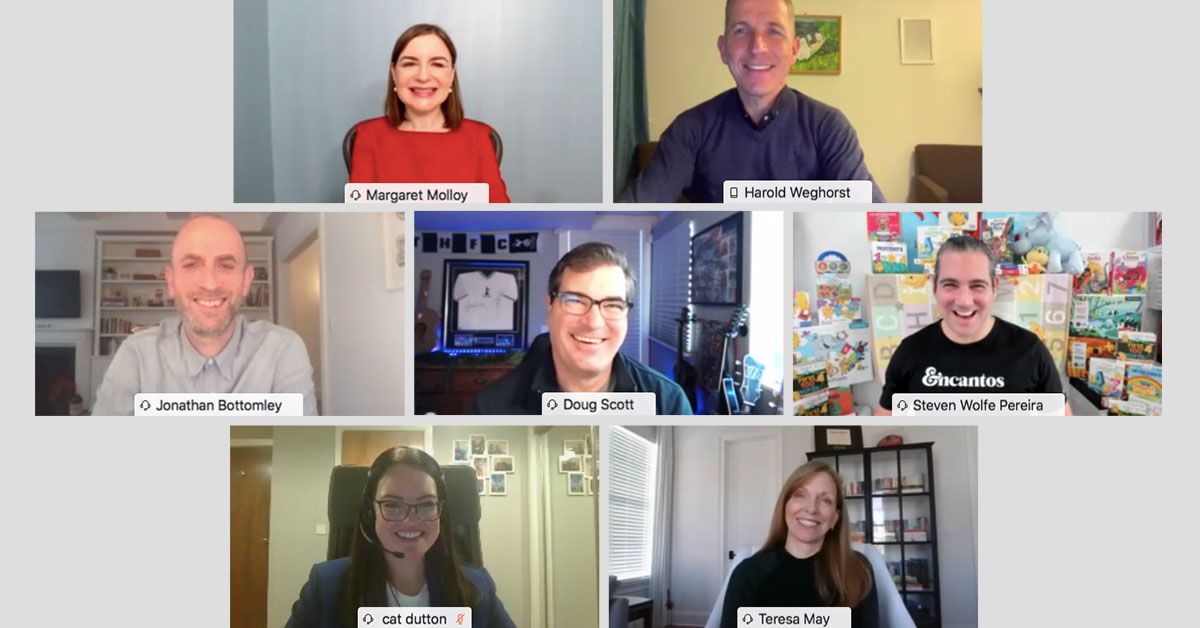Understanding buyer behavior and cultivating the habits that we desire of buyers has long been the bedrock of marketing and an outcome of successful brand building in both B2B and B2C business models. But what happens when a global pandemic wreaks havoc with all facets of life, from work to lifestyle? How do buyer habits change? Which ones will revert pre-pandemic? And perhaps more importantly, which new habits will persist?
On Wednesday, December 2nd, I explored these questions and more with global CMOs from Twitch, Ralph Lauren, Encantos, Lenzing, Atos and American Woodmark in the first in a two-part series examining the implications of shifting habits on brands. Our conversation explored the increasing demand for personalization, the power of community, the importance of brand messaging, the need for transparency around sustainability efforts and the rise of the subscription economy.
In closing, I asked the six marketing leaders: what has been your most significant learning from COVID-19 in terms of understanding buyer behavior and consumer habits, and how do you commit to staying in front of those evolving needs?

One of the things that 2020 has taught us is that live streaming has a broad audience of many people who haven’t been exposed to it yet. That will undoubtedly inform what we do in 2021, which is continuing to invest in international growth. There’s still a lot of growth for live streaming in many emerging markets worldwide, so that’s a significant area of focus for us moving forward. We’re also continuing to invest in some of the new verticals, bringing creators to the platform and encouraging them to bring their audiences along with them, which is a potent growth factor for Twitch.
I’m particularly focused on that creators’ interests are aligned with Twitch’s. We are thinking about how we can support them, and in doing so, encouraging them to build their livelihood on the service. By supporting them, we are helping the service grow.
My commitment is about continuing to build our community. People need community; they need a place where they can show up for one another, and that’s what we’re building. Everything for us comes back to that very core idea: how do we help people connect and stay connected and stay supported through the good times and the bad times?
—Doug Scott, CMO, Twitch
One of the main things I’ve learned is that people’s time is precious, and to reach one of those individuals is becoming increasingly challenging than ever before. So when we do get time in those individual’s diaries, it’s making sure that our message is on point, that we’re focusing on them and what they need and not necessarily what the company wants to sell. It’s all about them, and it’s about using that insight to help gain that advantage in that conversation.
My commitment to keeping pace with those buyers’ habits is to really listen to them, understand them, focus on what those customer insights tell us, and then reflect that back through our marketing. Being more creative with that, more innovative, and making sure that we’re engaging with them in a way that makes them feel understood and perhaps surprised by our level of engagement as well. We do have limited opportunities, and we must be on point with our message.
—Catherine Dutton, Global VP, Marketing, Atos
The biggest learning is probably a macro one: you go back to Maslow’s hierarchy of needs. If you think about habits, people under real pressure will revert to the bottom: safety, sustenance, shelter, etc. But we live in a very aspirational, capitalist world, and that needs one thing, but it wants desires, they’re very resilient. People will seek to access things that feel special that keep them entertained, connecting you to the things you love.
The digital revolution that we’re living through is a generational change; the habits of pivoting away from one way of accessing these universal truths around what you need and want to another form of accessing them. The learning for me is no one’s going to hang around and wait for you. You’ve got to be way ahead of that as a business; otherwise, people will move to access those things elsewhere. You have no God-given right to be the person, the group, the brand that supplies those things, and I think we’ve seen that. The retail industry has been turned upside down, and it’s not like people did not see it coming; it’s just been an accelerant.
I am committed to understanding what people need, what people want and how they want to access that. We are in the service business, and we have to serve what people want, what they need and how they want to get it. Personalization is about understanding that as well as you can and trying to pivot the business around to serve it brilliantly.
—Jonathan Bottomley, Global CMO, Ralph Lauren
If there’s one thing that we’ve realized this year, it’s that representation truly matters. Over 50% of kids in America today are diverse. But the lack of representation in entertainment and education is mind-boggling. With almost 30% of kids in America being Latino, you still don’t see any type of representation. So it has been an incredible learning seeing voices rise up as we have never heard before. It makes a lot of people uncomfortable; it makes a lot of employers uncomfortable. But keeping politics out of the workplace is no longer acceptable. People want to show up with their authentic self.
We are ensuring that you will see that diversity, equality and inclusion in every way that we bring story teaching to life. Our commitment is to help kids become lifelong learners. Having the representation come through is one of the critical things that we could have never envisioned that it would take a pandemic on top of the epidemic of systemic racism to make us timely. But we are in the middle of the zeitgeist, and we’re trying to deliver on that.
My personal commitment coming out of 2020 is living the values that learning is greater than education. How do you commit to being a lifelong learner but focus on being a 21st-century learner? I feel that these are the things that we cannot take for granted. I truly believe that taking the personalization from e-commerce and entertainment and bringing it into education is important because we all learn differently. That’s my commitment. You see it in the data. Some kids learn visually; for others, it is auditory. But there’s an incredible diversity in the way kids learn, and we’re more committed than ever to help kids learn that way.
—Steven Wolfe Pereira, Chief Executive Officer & Co-Founder, Encantos
There are three key learnings as I think about habit change during COVID related to our category. It’s about the resilience of people and families and how they define their spaces. The second is around creating connections and the importance of how we’re connecting externally and the role that our homes play. The third takeaway is around the creativity of the amazing things that people are doing with their spaces. It’s no longer just about functionality, but it’s a true reflection of themselves. So how do we keep creating products so consumers can access and design using those products to meet their needs and aspirations?
My commitment is to observe and participate, listen, adapt, and remember our products are helping buyers create those spaces. Whether it’s someone buying a new home through one of our new construction builders, how do we help that home come to life through the cabinets or through that experience? All the way to helping someone create their engagement as they think about what their next space is like through a digital experience or even accessing a human designer to help them bring their vision to life.
—Teresa May, SVP & CMO, American Woodmark
It’s crucial to remain agile as a company, as a business and as a brand, and to adapt to the situation. That’s the main thing. In the digital field, we saw a lot of changes. Not all were new; some had even started before, but they have accelerated. As a company, you need to be able to dial-up and adapt to that new occasion.
As to my personal commitment, that’s centered very much around sustainability. The textile industry, as well as other industries, have an obligation and a responsibility to leave the planet behind in a better state, at least to the extent of what I can do or what I can do with the company and with our brands. That’s what I want to contribute to.
—Harold Weghorst, Global Vice President Marketing & Branding, Lenzing Group
This is a biweekly series for brand-side senior marketers. To request an invitation, visit events.siegelgale.com


